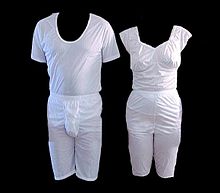Temple robe
The temple garment (also known as garment or temple underwear ) is a type of undergarment that Mormon devotees wear after receiving endowment . The garments are worn day and night and are mandatory for adults who want to visit the temple again after the first endowment ceremony . The underwear is seen as a symbolic reminder of the covenants with God in the temple and as a protection from the wickedness of the world. Today, temple garments are mainly worn by members of The Church of Jesus Christ of Latter-day Saints and, in a modified form, by some members of fundamentalist Mormon churches. For devotees, these robes are sacred and not intended for public display. Anti-Mormons have sometimes publicly displayed or destroyed temple underwear to demonstrate their opposition to the Church. Temple robes are sometimes pejoratively referred to as magical underwear by non-Mormons. Mormons see this term as misleading and offensive.
shape
The temple robe is white and knee-length for both sexes. For women, the top has a moderate neckline and narrow shoulder openings. The men's top has short sleeves.
All temple robes feature embroidery from the original endowment ceremony at Nauvoo Temple , an inverted V on the left chest, a mirrored L on the right chest, and small horizontal markings at the navel level and above the right knee. According to the endowment tradition, these were initially cuts in the fabric. However, they were soon replaced by embroidery.
The embroidery is reminiscent of square rulers and compasses, the symbols of Freemasonry , and was introduced into the Church by Joseph Smith shortly after he became a Freemason in Nauvoo. In the church, the embroidery is also given the same names as the Freemasons.
purpose
According to the Church of Jesus Christ, the temple vestments serve several purposes. First, they are a constant reminder to members of the covenants they made in the temple. Second, they are a protection against temptation and the wickedness of the world. Third, they are an outward representation of an inward obligation to follow Jesus Christ .
While many members believe that the temple robes give them spiritual protection, opinions about protection against real dangers are divided; there are stories related to this in Mormon folklore.
Holiness among members
Temple vestments remind members of the Church of Jesus Christ of their personal relationship with God and the temple covenants. Many members of the Church consider the temple vestments associated with temple ceremonies sacred. The President of the Church , Joseph F. Smith , taught that the temple garments "holiest of all things in the world, in addition to their own virtue, in addition to their own lives purity, are" the. For this reason, members avoid conversations in which temple vestments are disparagingly discussed. Some church leaders have compared temple robes to clothing worn by clergy in other churches. In contrast to other religious dignitaries, however, the symbols of inner obligation - the temple robes - are not worn in public. This is intended to encourage members of the Church to express their religious beliefs more about their exemplary behavior and thereby draw attention to themselves.
Doctrine of the Church of Jesus Christ
In the course of the temple instruction and the manual of the church it is pointed out that the temple underwear should be worn day and night and may not be changed independently. In the temple recommendation interview, members are asked whether they wear the robes day and night according to the covenant they made in the temple. Church members are encouraged to use the garment in any activity they can. If absolutely necessary, the underwear can be taken off on an occasional basis and put on again after the activity. For example, swimming is an activity that allows you to take off your temple garments.
Those who wear temple robes are advised to choose a modest style of clothing. In addition, the garments should not be consciously presented to the public in order to avoid misunderstandings.
Individual evidence
- ↑ Topic . In: MormonNewsroom.org . LDS Church. Retrieved October 20, 2014.
- ↑ Jennifer Dobner: Group aims to dispel Mormon myths, explain beliefs: Mormon Defense League aims to educate journalists, politicos about Utah-based faith's beliefs (en) . In: Reading Eagle , August 4, 2011. “Misinformation or misperceptions about Mormonism including that faithful Latter-day Saints wear“ magic underwear ”or still practice polygamy stem from a lack of understanding of the church's history, doctrine and culture, Gordon said. "
- ↑ Tresa Edmunds: Mormon underwear keeps body and soul together (en) . In: Guardian Unlimited , March 1, 2011. "I get a lot of questions about my 'magical' underwear, but our garments are just like a Christian cross or a Jewish yarmulke."
- ^ Robert A. Rees : Is Nothing Sacred? Thoughts on Mormon Undergarments . In: religionnews.com , Religion News Service , August 24, 2012. Archived from the original on October 22, 2014 Info: The archive link was automatically inserted and not yet checked. Please check the original and archive link according to the instructions and then remove this notice. . Retrieved October 21, 2014.
- ↑ Peggy Fletcher Stack : Church posts pictures, video explaining Mormon 'garments' . In: The Salt Lake Tribune , October 20, 2014. Archived from the original on October 21, 2014 Info: The archive link has been inserted automatically and has not yet been checked. Please check the original and archive link according to the instructions and then remove this notice. . Retrieved October 21, 2014.
- ^ LDS Church (2010, Handbook 1 § 3.4).
- ^ Smith p. 813
- ^ Commentary . In: MormonNewsroom.org . LDS Church. April 24, 2007. Retrieved October 20, 2014.
- ^ Packer, 2002
literature
- Joseph F. Smith: Editor's Table . In: Improvement Era . 9, No. 10, August 1906, pp. 812-815.
- Boyd K. Packer: Preparing to Enter the Holy Temple . LDS Church. 2002. Retrieved January 16, 2015.
